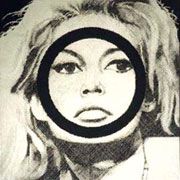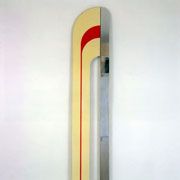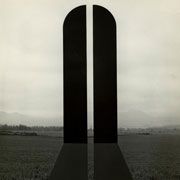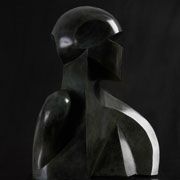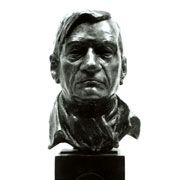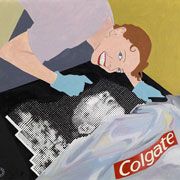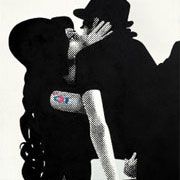
Catalogue Raisonné. Division
Search the Catalogue
Division
Catalogue No. 289
Artist's CR 280
1971
Kinkell
Paint on steel
100 x 720 x48 inches / 254 x 1829 x122 cm
Collection: Aberdeen City Council
- Private collection
- Collection of Aberdeen City Council
- 1971: Gerald Laing, Scottish National Gallery of Modern Art, Edinburgh, 1971
- Laing Mylius Scobie, Cleish Castle, near Kinross, 1975
- Sculpture in the Highlands: Landmark and Glenshee, The Landmark Sculpture Park, Carrbridge, 1980
- Sculpture Exhibition, The Highland Council, Inverness, 1990
- Gerald Laing and Alasdair Hamilton, 1971: Gerald Laing, exhibition catalogue, Scottish National Gallery of Modern Art, 1971
- Laing Mylius Scobie, exhibition catalogue, Cleish Castle, 1975
- Sculpture in the Highlands: Landmark and Glenshee, exhibition catalogue, The Landmark Sculpture Park, 1980
- 'Divisive Sculptor on the Trail of the Great Detective', Inverness Courier, 1990
Division is intended literally to divide the prospect before which it is placed. The downthrust of the central part seeks a sideways relief. In this sense the sculpture is a gesture but it also has figurative forces.
Sculpture in the Highlands: Landmark and Glenshee, Gerald Laing, exhibition catalogue, The Landmark Sculpture Park, Carrbridge, 1980, p.8
The huge Division of 1971… is another application of two of his ceremonial axe shapes, joined at the head, their 30 foot shafts sailing sideways from their central support, so that in spite of its great size, the piece seems light, almost potentially airborne.
Laing Mylius Scobie: Sculpture at Cleish, Douglas Hall, exhibition catalogue, Cleish Castle, near Kinross, 1975, p.9
The essentially horizontal character of this sculpture contrasts sharply with the vertical trunks of the pine trees. The structural possibilities of sheet steel are used to dramatic effect. It will be noticed that the splayed ‘legs’ of the sculpture rise a little above the horizontal - to counter our propensity to see a straight projection as a droop. Division presents itself with the taut energy of a gymnast; it bestrides the forest - like a fertility Goddess.
Sculpture in the Highlands: Landmark and Glenshee, Timothy Neat, exhibition catalogue, The Landmark Sculpture Park, Carrbridge, 1980, p.8
‘The idea of all my abstract sculpture was that it should influence the environment,’ he [Laing] explained. “It was my intention that Division should be placed symbolically in front of something, splitting it into two halves and making a gesture downwards and outwards. Its most arrogant location was when Richard Demarco erected it in front of Hopetoun House, splitting the symmetry of an elegant historic building - but then, it’s a very arrogant sculpture!’ For many years, Division, acquired by Michael Spens, publisher of the art Magazine Studio International, stood amid the remains of the Great Caledonian Pine Forest at Carrbridge where it formed part of the sculpture trail at Landmark Visitor Centre. ‘I lost track of it after that,’ Gerald said. ‘I haven’t seen it for 15 years.’
1990

